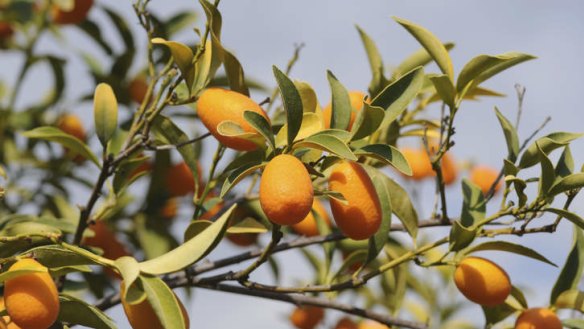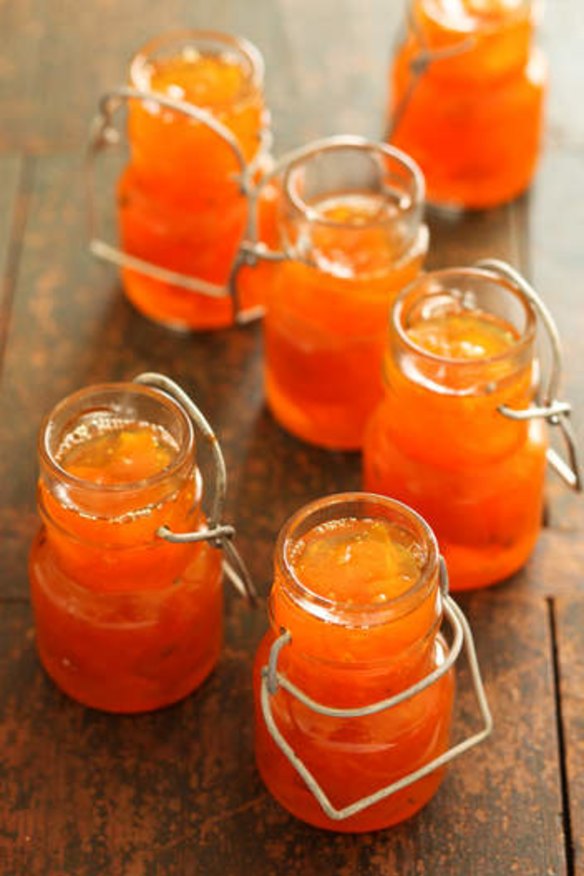Queen of marmalade: cumquat

A group of gardening aficionados in Australia read the English magazine Country Life, published since 1897. I browse copies from a Canberra library. In one of those I came across a letter to the editor entitled ''Cumquat: queen of marmalade'' from Emeritus Professor Graham Cooksley, of Queensland. He was sympathising with the British, who make orange marmalade but cannot grow the small citrus, calamondin (but usually called cumquat), which makes the most exquisite of marmalades.
In my rounds of Canberra's kitchen gardens I often see cumquat shrubs. For 20 years in my former garden I grew a cumquat in a pot on the front porch and its perfumed white flowers, followed by small golden fruits, made a perfect welcome. I regularly made marmalade from its fruit. In my garden today, a cumquat, also Fortunella Marumi variety, has been growing in a terracotta pot for 18 years and it is kept going with weak solutions of Seasol. During November it had an exceptional crop and I harvested 150 cumquats and gave them to a country friend who is a keen preserver. My reward was a jar of the very best marmalade to land on a piece of toast.
Through the web I tracked down Professor Cooksley and he rang me on the eve of Christmas. He was born in 1940 and says that after the war, food parcels were sent to relatives in England. He says everyone in Brisbane had a cumquat in those days and his mother's cumquat marmalade went into the parcels. His job as a small boy was to stir the marmalade.

The Cooksleys lived in a historic house, Beaufort, at Maleny and their garden was part of Australia's Open Garden scheme. A year ago they downsized to a more manageable 0.5 hectare garden, where they have planted a calamondin and a cumquat in a pot because they are so beautiful to look at. His marmalade has been entered in the Maleny show and the recipe is above.
In The Garden Plants of China, Dr Peter Valder says huge numbers of cumquats and other citrus are grown in China ''and sold for indoor decoration, particularly for the New Year. Covered with golden fruits, they are highly ornamental and are symbols of good fortune and prosperity.''
In 1915, cultivated cumquats were given the name Fortunella in honour of Robert Fortune, who brought a plant from China to England in 1846.
Valder refers to the calamondin as Citrus x microcarpa.
Dr Louis Glowinski, in The Complete Book of Fruit Growing in Australia, also calls the fruit kumquat. He says Fortunella crosses easily with citrus.
Prince Charles was the guest editor of Country Life in November 2013 to mark his 65th birthday (the edition comes to Canberra news agencies soon). It features rural heroes, organic growers, Duchy Original biscuits and the Queen Mother's garden in Scotland.
Graham Cooksley's cumquat marmalade
Pick a large saucepanful of the fruit (about one kilogram). Wash cumquats, pick off any stems and process them the same day. Slice by hand or use a mandolin that will cut 3mm slices. Leave the seeds in as a source of pectin. Cover the fruit with water and leave overnight.
Next morning, bring the fruit and water to the boil and simmer gently for an hour, stirring occasionally. Then add sugar (preferably brown sugar, as it helps to caramelise). Add sugar: one part sugar to one part fruit - or, if you prefer the marmalade to be slightly tart, about two thirds - go by taste. Then boil vigorously to help the sugar caramelise. After about 30 minutes of boiling, remove the seeds. When the marmalade coats the back of a spoon it is ready to bottle. Waste no time, otherwise the marmalade will set in the saucepan.
Use a small jug to transfer marmalade to about eight jars (previously sterilised in boiling water) then, using rubber gloves, screw on lids (also sterilised). Allow jars to stand and cool before storage. Cooksley no longer uses a wax topping, because if the bottling is done quickly there are no problems with mould. He does not use pectin or citric acid, because it dilutes the taste.
>> Susan Parsons is a Canberra writer.